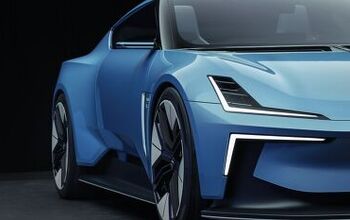Canada's Largest EV Market Quietly Rolls Back Massive Government Subsidy (Again)

Ontario, that strange land located between Detroit and Buffalo (and elsewhere, too) became the largest Canadian market for electric vehicles in 2017. There was good reason for it, too. Imagine walking into a dealer showroom, eyeballing a flashy luxury car, and suddenly your local political representative rushes in and hands you a check for $14,000, no strings attached.
Thanks, fellow taxpayers!
This subsidy is what buyers of Tesla Model S and X vehicles, retailing for over six figures (Canadian MSRP), enjoyed in Ontario until very recently. It’s important to note, though maybe not to certain folks, that the province holds the world’s largest sub-sovereign debt, most recently tagged at $311 billion, and pays over a billion dollars a month to service the interest on that debt.
Sorry, Ontario Tesla buyers. The party’s over. Again.
As of March 9th, there’s zero incentives awaiting big-bucks EV buyers. While there’s still $7,000 to $14,000 in the till for buyers of EVs or PHEVs costing less than $75,000 the new cutoff means there isn’t a cent for higher-end cars, and this author couldn’t be happier.
As part of the Ontario government’s green energy/climate change push, an initiative dating back to 2009, electric and plug-in hybrid vehicle are eligible for a range of subsidies. The province’s Green Energy Act (2009) also pushed electricity rates through the roof as a result of contracts signed for renewable solar and wind energy at exorbitant rates. Currently, Ontario pays neighboring U.S. jurisdiction to take its excess energy, and the cost of that transfer shows up on ratepayers’ bills. (Conservation comes easy when electricity’s relatively expensive, making the province’s power surplus easy to understand).
Under the province’s Electric Vehicle Incentive Program, buyers were once eligible for rebates totalling up to $8,500, depending on battery size. Long-range vehicles like Teslas garnered the most incentives. However, in 2016, the province backtracked on the subsidy free-for-all, capping the incentives for EVs or plug-in hybrids costing between $75,000 and $150,000 at $3,000. In doing this, it made cheaper EVs containing five seats eligible for up to $14,000 in subsidies.
In areas where transit, healthcare, homelessness rates, housing, or infrastructure isn’t perfect, hauling $14,000 out of government coffers and handing it to a luxury car buyer could seem tone-deaf, especially when it’s billed as a progressive move. And yet, inexplicably, the Ontario government removed the MSRP cap a year later, making any vehicle eligible for the maximum subsidy. This change came into effect, retroactively, on January 1, 2017.
Guess what? Buyers are much more likely to buy an electric vehicle when the government foots part of the bill! Last year, some 7,477 EVs and PHEVs were sold in the province, surpassing Canada’s former green car leader, Quebec. (Both Quebec and British Columbia offer green car incentives, but nowhere near as high as Ontario’s.)
In the case of low-end EVs like the Hyundai Ioniq or Chevrolet Bolt, the Ontario subsidy pushes the net price down into the low $20k range — not bad for someone looking for a zero-emission vehicle to tool around the city in. For top-end, long-range vehicles, however, the subsidy pushes the entry price to — perhaps — under $100,000. Most observers in the median income range, the types who keep an eye on dollars and cents in order to afford groceries and bills, probably didn’t think much of this policy, especially when the Ontario government added a carbon tax at the gas pumps.
As the province counts down to a June election, the governing Ontario Liberal Party, in power for 15 years, seems reluctant to keep the high-class/low-emission party rolling. While hydrogen vehicles have been added to the subsidy (despite a lack of refueling stations), the price ceiling for EVs now seems ironclad. Clearly, it’s one way of keeping the projected deficit to a trim $8 billion in the coming year.
According to the government, “incentives will be provided under the previous EVIP program for EVs ordered prior to March 9, 2018, provided that the EV is delivered and that the application is submitted by September 7, 2018.” This insulates the province from any lawsuits filed by Tesla buyers blindsided by the silent change to the government’s EV policy.
While your author applauds the move, not everyone’s happy about it. As internet posters squabble about what tax dollars are really for, Ontario has also beefed up its electric vehicle infrastructure spending. If you’re a business looking to install a Level 2 EV charging station, Ontario will pay 80 percent of the cost of installation, up to a total of $7,500.
It’s worth noting that most configurations of the Tesla Model 3, at the very least, will be eligible for the incentive. If it doesn’t, then Musk’s “affordable” electric vehicle isn’t the people’s car he envisioned.
[Image: Hyundai]

More by Steph Willems
Latest Car Reviews
Read moreLatest Product Reviews
Read moreRecent Comments
- 3-On-The-Tree My 2009 C6 corvette in black looks great when it’s all washed and waxed but after driving down my 1.3 mile long dirt road it’s a dust magnet. I like white because dust doesn’t how up easily. Both my current 2021 Tundra and previous 2014 Ford F-150 3.5L Ecobomb are white
- Bd2 Would be sweet on a Telluride.
- Luke42 When will they release a Gladiator 4xe?I don’t care what color it is, but I do care about being able to plug it in.
- Bd2 As I have posited here numerous times; the Hyundai Pony Coupe of 1974 was the most influential sports and, later on, supercar template. This Toyota is a prime example of Hyundai's primal influence upon the design industry. Just look at the years, 1976 > 1974, so the numbers bear Hyundai out and this Toyota is the copy.
- MaintenanceCosts Two of my four cars currently have tires that have remaining tread life but 2017 date codes. Time for a tire-stravaganza pretty soon.


































Comments
Join the conversation
Well, we have a new Progressive Conservative leader elected. The one who does not support elite. The one who wants to cut bureaucracy. Almost 80% of Ontario's population is fed up choosing between heating and eating. He wants to get rid of Carbon Tax and a Green Energy Act, yet he wants to remain environmentally responsible. I hope that the people of Ontario will support him on June 7 and that he will form a new majority government.
How much of those incentives is a simply VAT refund? Methinks this may not be costing them net anything, thoughts?